Cover 3 is a weekly feature column written by PewterReport.com’s Tampa Bay Buccaneers beat writer Trevor Sikkema published every Tuesday. The column, as its name suggests, comes in three phases: a statistical observation, an in-depth film breakdown, and a “this or that” segment where the writer asks the reader to chose between two options.
SIKKEMA’S *SCHEME* OF THE WEEK
New section, who dis?
So, as you can see, we have a bit of a change in the way the Cover 3 is set up this week. Over the past few weeks, we’ve taken a couple of the Buccaneers’ top draft prospects, O.J. Howard and Chris Godwin, and used both statistics and an extensive film review to better understand why the team drafted them and exactly how they project to this Bucs team with this Bucs coaching staff.
Safety Justin Evans is next on the list of prospects I definitely want to go over, but I’m putting his film review off for a week to touch on a more pressing topic lately and that is the perceived transformation of the Buccaneers’ defense in year two of Mike Smith as defensive coordinator.
If you’ve been keeping up with PewterReport.com, you’ve surely read the quotes and articles highlighting potential changes to the defense, not only in an advanced form of assignments and roles, but also schematically with how they line up in base. You’ve heard on our Pewter Nation Podcast that we believe the defense is going to get more multiple and more versatile, but we don’t think a full scheme switch is coming.

Bucs DC Mike Smith – Photo by: Cliff Welch/PR
We’ve used terms like “3-4” and “4-3”, and I’ve come to explain that a little bit, both in written and audio form. However, I acknowledge that I have yet to really give Bucs fans the “101” of what all this terminology and switching really means. It’s not just about one player changing position. Where each player lines up in a certain front determines how the entire defense plays around them. It changes the motive, the goal and the potential of each player at each spot.
So, rather than continue to go on talking about these defensive schemes as if everyone understands what they are, I thought it would be useful to breakdown the characteristics of defensive fronts while pairing them with the Buccaneers’ current roster. That way we can really understand the positives and negatives that would come with any kind of position change, and you could be more informed in your opinions as they come – not calling anyone out as wrong or anything, but I always want to make it my goal for Bucs fans to become more informed on the game and the team they love each time they visit this site.
So, let’s get into it with what the Buccaneers have been running for a long time – the 4-3.
Intro to 4-3
Explaining a Front; Identifying Gaps
Defense, in its nature, is the adjustment side of the ball. Offense is the side that typically dictates how both teams are going to line up each play with personnel and spacing, and its the defense’s job to react to where the offense goes when it breaks the huddle and to line up accordingly. But, that’s not to say the defense won’t have its play call in before the huddle is broken, they just have to move or shift in a manner that can counter or contain the offense’s look as best it can with whatever defensive play that is called – usually defensive coordinators know what’s coming next so they can call a play or formation that would contain it well anyways.
Knowing that it’s the offense that sets the tone for how both teams line up, in order to understand how a defense adjusts its front, we have to understand gaps in the run game.
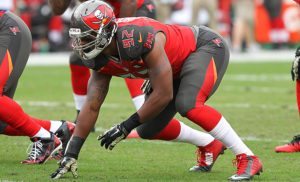
Bucs DE William Gholston – Photo by: Cliff Welch/PR
So, what is a front? A front stands for a “front seven.” With 11 total players on one side of the ball, the “front seven” are the seven players on defense that take up the defensive line and the linebackers. This is also referenced as the “box” – sometimes you’ll hear the term “box safety,” that means it’s a safety who plays near the box (or line of scrimmage) to help in run support more than play back in coverage.
This also explains the numbers that we hear when referencing a formation. A “4-3” denotes the number of players that are either on the defensive line or with the linebackers. The first number is always the number of defensive linemen – that means players who line up with their hand(s) in the ground. That “hand in the ground” part is important, because even though there could be an edge player who is rushing the passer or disrupting the pocket like a defensive linemen, if he doesn’t have his hand in the ground, he’s not considered a “down lineman” a.k.a. a defensive lineman. So, in a 4-3 there are four defensive linemen and three linebackers.
The point of having your hand in the ground is for leverage. If you’re playing defensive line and trying to knock back or simply occupy offensive linemen, you want to have the lowest leverage so you can push them upward and best move them where you please. On the flip side, if you’re coming from a standup position, that likely means you’re relying on speed more than leverage. From an up-right position, you can have a faster get off and can bend around an offensive lineman easier on the edge.
To not get confused, I always try to just think about things naturally. Think if you yourself were doing these tasks. If you were going to try to push someone out of a spot, you wouldn’t want to hit them high. That would mean you could lose your balance if they pushed you back. Instead, you’d want to get low and wide. Look at high school wrestlers, for example. They always start and engage low because it allows them to stay balanced and engage their leg strength to move their opponent. That’s why defensive linemen do it. Same kind of physics.
(I know that was a lot of extra info, but I want to be thorough.)
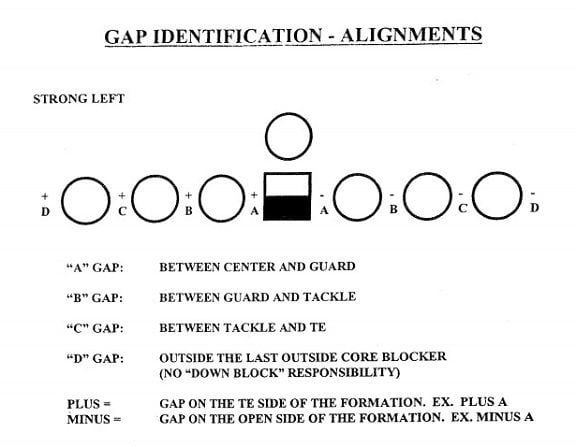
(via smartfootball.com)
So, now that we understand a front, let’s get to why there are different kinds and what they mean.
I’ll start by saying this: Every. Single. Aspect. Of. Defense. Revolves. Around. Stopping. The. Run.
Got it? Good.
Even in an age where college football and the NFL are becoming more pass-heavy leagues, success in the passing game only comes from success in the running game. Unless you are truly just that much better than your competition (which is unlikely in the NFL), if you can’t run the ball, you’re giving the defense a huge advantage. Think about it, even in games where a team’s running game is averaging less than four yards per carry and has under 150 yards, if you can’t run the ball, those third-and-3 situations are no longer easy, and the defense already has an advantage making you pass on short yards.
In order to stop the run game we first have to know how it operates. Running the ball comes in four different “gaps”: A, B, C and D. As shown in the diagram above, the A gap is the one on either side of the center, the B gap is in between the guard and the offensive tackle, the C gap is between the tackles and a tight end, and the D gap is what we would call “bouncing it to the outside.”
Here’s what that looks like on the field.
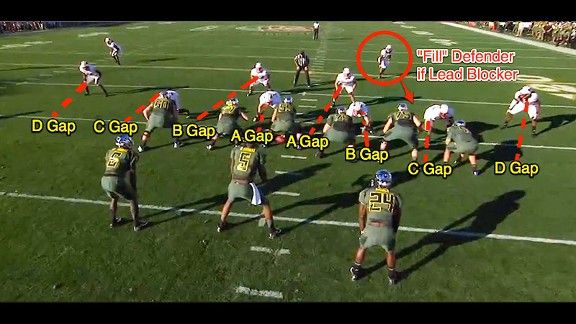
(via smartfootball.com)
Defensive Alignment
It’s important to understand gaps in the run game because gaps ultimately determine where each defensive lineman is positioned so he can best defend a potential running play based on his assignment (which could be taking up one or two gaps, we’ll get to that later).
I’m sure you’ve heard the term “3-tech”, “5-tech” or “nose tackle” before, and this is the part where we explain that and why each is important.
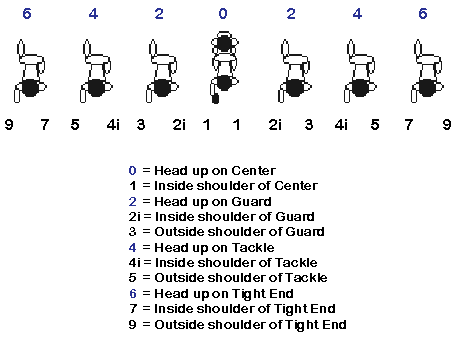
(via Coach Z)
Each number in the diagram represents a certain “technique” or alignment a defensive lineman can have on any given play. The number starts at zero in the very center, and goes out in both directions. Where each player lines up has a big say in whether or not the defensive lineman is rushing the passer or just eating up blocks.
In a 4-3, the alignments are usually a nose tackle set up as either a 0-tech or a 1-tech, a defensive tackle set up as a 3-tech, and two defensive ends which could be aligned either as 5-tech, 7-tech or a 9-tech, depending on the player and the gameplan. For the Buccaneers, defensive ends like William Gholston and Robert Ayers would be more of 5-tech players due to their size and power pass rushing, where defensive ends like Noah Spence and Jacquies Smith could be used more as 7-tech or 9-tech players due to their speed off the edge.
The interior defensive alignments don’t change too much the nose tackle and defensive tackle. But, in order to understand where the defensive ends would line up, we have to identify the meaning of an “open” and “close” play.
“Open” vs. “Closed”
When the offense goes to the line of scrimmage, the defense will “set” one side of the field as open or closed – this is also called the “strong” and “weak” sides of the field. The “closed” side, or “strong” side,” is the side where the tight end is lined up. Usually this happens on the right side of the field (if looking at the ball from behind the offense) so he can help block with the right tackle rather than giving help to the left tackle.
This bring us to explain the three linebackers in the “4-3” front. The three linebackers aren’t just a middle and two outside linebackers. Instead, they’re identified as the “Mike”, “Sam” and “Will” linebackers. Those players are easy to remember because all you have to do is match the first letter of each name.
- Mike = Middle linebacker
- Sam = Strongside linebacker (where the tight end is*)
- Will = Weakside linebacker (where the tight end is not*)
*If the offense plays with two tight ends, the defensive will have identified which tight end will be the “setting” tight end during the week when formulating the gameplan.
Knowing why each linebacker is called can also help us identify playing roles. For example, we’ve heard multiple times throughout the offseason that the Buccaneers wanted to get bigger at the Sam linebacker position, and how they’re excited to have Kendell Beckwith’s size as an option when he heals up. Now you know why. Since the Sam linebacker is the one that plays to the strong side with the tight end, they’re going to be the ones who are asked to help collapse the pocket if the tight end is blocking, or help set the edge on a run play to the outside. This requires a much bigger frame with more strength than say a speed rusher or your average athletic linebacker.
On the flip side, this also helps us identify why Lavonte David is such a good Will linebacker. Since the Sam linebacker is playing closer to the line of scrimmage with the tight end on the closed side of the field, they’re the ones who make plays through contact. Will linebackers, on the other hand, make their plays in space. They have to be able to cover a lot of ground and make tackles in the open field. It’s also their job to shoot gaps in the offensive line when pass rushing. “Weakside” in no way means a lesser player as some confuse the name with.
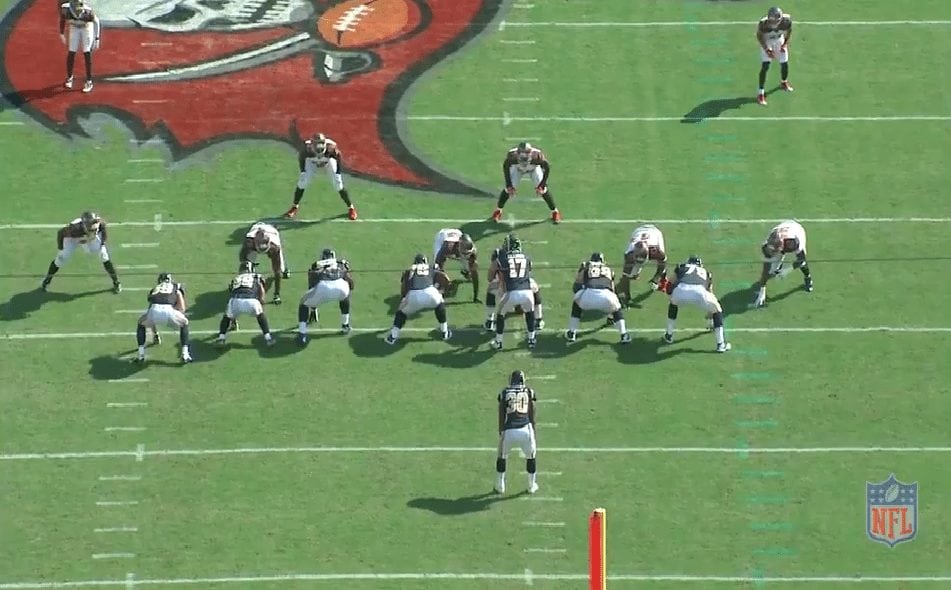
The play above shows a good example of the Buccaneers’ 4-3 Under alignment to the “closed” side. As you can see, the Los Angeles Rams had, not one, but two tight ends to their left (defense’s right). So, this play was “set closed to the right”.
As you can see, Daryl Smith is lined up as the strong side linebacker on the side of the tight ends and closer to the line of scrimmage. This is why he needs the size to take on those tight ends. Alternatively, look at all the space David has to cover on the weak side with the defensive shifted over to the closed side. That’s why his athleticism is important.
Now that we know offensive gaps, interior alignments, linebacker responsibilities and closed vs. open, we can bring it all together an explain the two kinds of 4-3 setups.
Two Types of 4-3: Under and Over
Playing in a 4-3 vs. a 3-4 is all about how you intend to disperse the responsibility of gap control in the run game from the four gaps that we identified earlier. In a 4-3, most of what the defensive linemen and linebacker are assigned is with one gap in mind. With a 3-4, each of the players along the trench will be “2-gapping” instead.
Here’s what that looks like in a straight up 4-3 base.

As you can see, each member of the front seven is responsible for one gap in the run game (that’s priority number one). The idea behind a 4-3 defense is that it allows for the 3-tech defensive tackle and the 5-tech weak side defensive end to get one-on-one match ups more often than not thanks to, in theory, good play from both the nose tackle in the middle taking up blocks and the strong side defensive end being able to set the edge by himself. It also makes it easier for the linebackers to read and react to a hole in the defensive line and either fill it with a pass rush or stop a runner going through that gap.
But, alignments aren’t always that simple. Sometimes base defenses need a little adjusting to bring help where needed. That’s where “Over” and “Under” adjustments to a 4-3 come in.
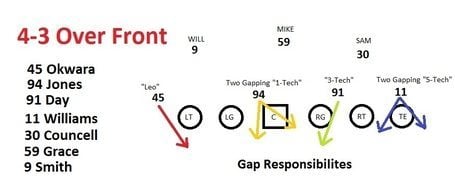
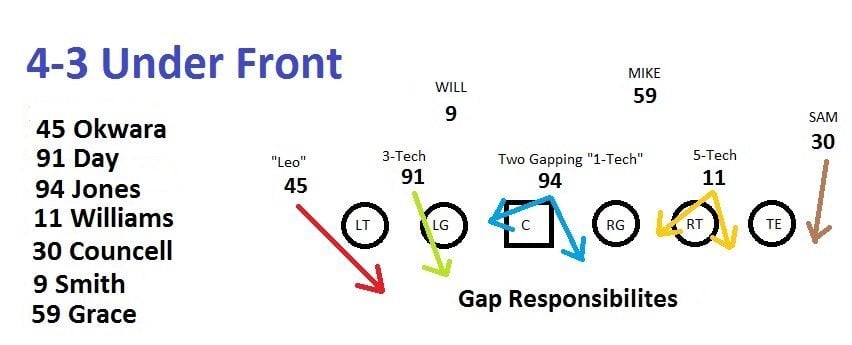 The difference between “Over” and “Under” have to do with which side of the field the tight end is on, but then from there, where the nose tackle and defensive tackle are lined up.
The difference between “Over” and “Under” have to do with which side of the field the tight end is on, but then from there, where the nose tackle and defensive tackle are lined up.
In both of the examples above, the tight end is on the left side. However, in the “Over” front, the 3-tech defensive tackle is lined up on the “closed” side with the tight end and in the “Under” formation he’s line up as a 3-tech on the open side. In a 4-3, the defensive tackle will always be lined up in a 3-tech spot because this is always the spot where he can either shoot a gap quickest or at least has the highest probability of getting a one-on-one matchup. The nose tackle also moves as the 3-tech defensive tackles does with “Over” and “Under” fronts. In the “Over” formation, he’s lined up on the open side of the outside shoulder of the center, and on the “Under” side, he flips and does so on the closed side. This adjustment is to make sure the spacing is right for him to take on multiple blocks in the middle and give the defensive tackle his one-on-one.
You can also use a cheat sheet when identifying “Over” and “Under” formations by looking at where the Sam linebacker is. If he’s lined up on the line of scrimmage, that’s a give away that it’s an “Under” front. If he’s line up closer to where the other linebackers are, it’s a sign of an “Over” formation.
Whew. That was a lot of words, so let’s try to say all that in layman’s terms.

Bucs DT Gerald McCoy – Photo by: Cliff Welch/PR
In a 4-3 defense, the 3-tech defensive tackle is the star. The front is designed to give him minimal jobs beyond just dominating his gap and getting into the backfield. For the Buccaneers, that’s Gerald McCoy. Playing 3-tech requires speed off the snap as a pass rusher with power and technique when holding a gap. McCoy is one of the best 3-tech defensive tackles in the NFL, and that’s the reason the team has been in the 4-3 formation for as long as they have been. When he gets one-on-one match ups, the advantage is his. Interior pressure is a killer for a quarterback because it forces him to move.
The second most important player in a 4-3 defense is the weakside defensive end (or “open side”, the defensive end without the tight end). This is the pass rusher who not only doesn’t have to worry about extra blocks from a tight end, but also gets to go up against the lesser offensive tackle on the right side. For the Buccaneers, that is Noah Spence. Weakside defensive ends win with speed. It takes a true athlete to be able to have success as a weak side defensive end, and Noah Spence showed flashes of that last year. He said he’s trimmed down his body fat over the offseason to get even faster.
The third key position for the 4-3 defense is the Will linebacker. This is David. In order to run the 4-3 successfully, you have to have a linebacker who is both athletic and intelligent enough to anticipate, cover ground and make plays in space. This is the player who is going to pursue the ball, regardless of side, and will usually be the tackling leader on the team.
So, in the “Too Long; Didn’t Read” version of all of that, a 4-3 is all about one-gap assignments. It’s about getting the 3-tech player and the weak side defensive end the best pass rushing opportunities, and it’s about allowing your most athletic linebacker to be the show stopper, if the ball gets out of the backfield.
Sounds perfect for the Buccaneers, right? It does, but as offenses in the NFL evolve with diversity and versatility, so must defenses. On the next page, we’ll go over the essentials of a 3-4 defense, and what that might look like for the Buccaneers with their current roster, if Mike Smith chooses to make that a situational option – and the occasions that may call for it.




